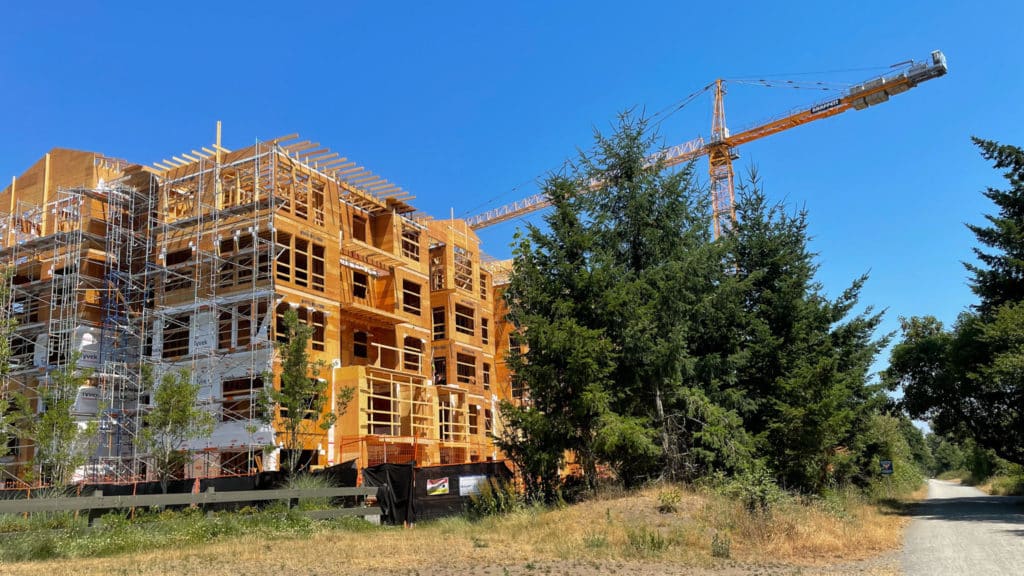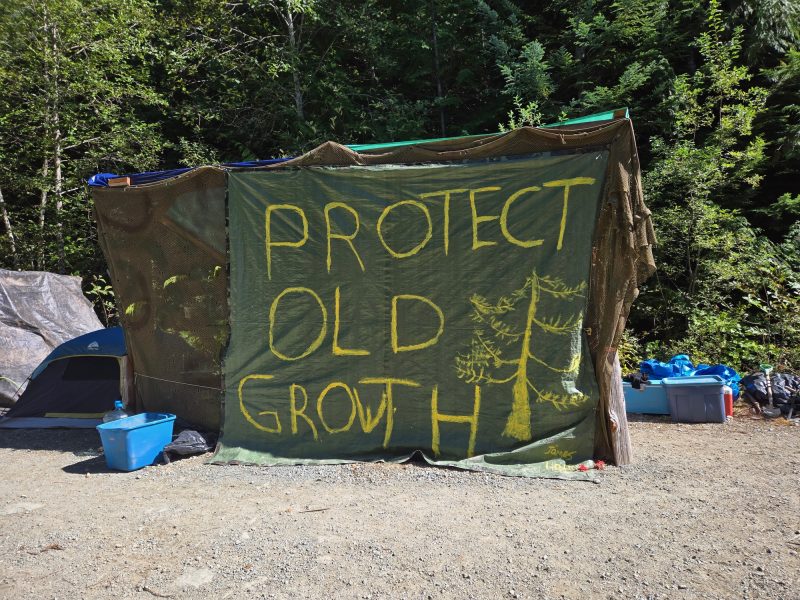
Two decades ago, the City of Langford looked quite different than it does now. A community that was once referred to as “the dogpatch” has grown at break-neck speeds, absorbing far more than its share of the Capital Region’s growth pressure.
The city celebrates its growth and ability to offer affordable housing options as families are priced out of the market in neighbouring communities like Victoria.
“In many ways, the West Shore has rescued the entire region from an affordability standpoint,” says Leo Spalteholz, a real estate analyst who created House Hunt Victoria and member of community advocacy group Homes For Living. “If the West Shore had the same housing policies as the core municipalities, who knows what prices would be. Certainly, many people that would like to live here would never be able to live here.”
But as development continues, space is becoming an issue. If Langford wants to continue to be a place where all sorts of people and families can afford to live, it must embrace density and diversity, Spalteholz says. Larger scale developments like My Belmont and Belmont Market, when done right, can improve affordability and livability while limiting urban sprawl and pressures on green space.
‘The transition time is now.’
Much of Langford’s rapid growth has come in the form of single-family houses in residential subdivisions. But to accommodate the ongoing pressure to house more people, the municipality must now turn to higher-density developments.
“Langford probably has about 10 years of greenfield land left before they’re also out,” Spalteholz says. “And then after that, we’re either going to see intense pressure to open up [agricultural land reserve] land and other forested lands up the Malahat — or we’re going to have to densify.”
Related: Towards and affordable and liveable West Shore
That’s precisely the plan, Langford Mayor Stew Young tells The Discourse. “That is the future, otherwise you end up with sprawl everywhere,” Young says. “We can still have our single-family homes in certain areas but we can’t just have single-family homes without going higher. The transition time is now. Langford has evolved.”

The City of Langford has already made moves to add density to the core with various apartment and condominium buildings dotting the downtown area. Langford’s Official Community Plan highlights the city centre as an area intended for high-density development, particularly along transportation corridors like Goldstream Avenue and the Island Rail Corridor.
Village centres in Langford like the Bear Mountain and Westhills developments, mixed-use centres like Millstream Village and the Westshore Town Centre and various business and neighbourhood centres are identified as intended growth areas, too. A map of these areas can be found here.
“There’s no endless supply of land,” he says. “For a community our size, we build a lot of homes for families and that’s how Langford was built. Now we have the economy here, we have jobs, you can raise a family here. … We want to see more condos being built — and affordable ones. The only way you can make affordable condos is to [build] higher.”
Inside My Belmont
Density alone doesn’t make for an affordable and liveable city. But, when done well, larger developments can contribute to a better quality of life for residents and neighbours.
One development in particular — My Belmont — checks many different boxes when it comes to an affordable housing solution. Located just off Jacklin Road adjacent to Belmont Market, the My Belmont development has a mix of rental and condo units with amenities like restaurants, grocery stores and shopping within walking distance. The Galloping Goose Regional Trail is steps away from the residences, as are major bus and transportation routes.
With transportation costs making up a large chunk of expenses for residents on the West Shore, amenities, jobs and alternative transportation routes that are accessible and within walking distance can help make housing more affordable, Spalteholz says.
The development also offers a unique rent-to-own program for potential homeowners. In collaboration with the City of Langford, developer Ledcor Group agreed to a program that helps renters save for a down payment on one of the My Belmont condominium units. Those renting in the Crossing at Belmont building pay market rent prices, with 25 per cent of their rent accruing towards points that can be cashed in for a down payment in a My Belmont condo, up to a maximum five per cent of the home’s value. The City of Langford also funds a $5,000 rebate that is applied to the deposit.
Young says this rent-to-own program through the City of Langford is available for other developers to be a part of as well. The city is also working with the Westshore Developers Association to look at more affordable home ownership options to help people get into the market. Young says a new affordable home ownership program is in the works and will likely go to Langford City Council in the next few weeks.
There are 20 spots available in My Belmont’s rent-to-own program and Marcela Corzo, director of development with Ledcor, says eight of the spots are already taken. Residents are already moving into their new condo units, Corzo says, while others are waiting for the next phase of building to be completed before they move.
“More people are having challenges getting the downpayment,” Corzo says. “This isn’t going to solve your housing problems, but it helps.”

Condos alone are not enough
Developments like My Belmont will meet housing needs for many, but different kinds of higher-density housing are needed, too, Spalteholz says,
Right now, Spalteholz says not many high-density rental developments are appealing to families. Finding a three-bedroom unit is rare, he says, and often expensive. This pushes families to rent from private owners in homes or basement suites. The issue there, he says, is that they could have to move at any time.
Data from Statistics Canada says B.C. sees the highest number of forced moves in the country. In 2019, The Tyee reported that 10 per cent of British Columbians who moved between 2014 and 2018 say their housing change was forced because they were evicted by a landlord or a bank foreclosed on their home.
Spalteholz says given the increasing scarcity of land and subsequent rising costs of single-family homes, options like condos, purpose-built rental apartments and townhomes that can accommodate families will be needed. Families in particular need rentals that are large enough for them, affordable and secure.
Growing pains
Making room for more people in urban Langford won’t be painless. Residents continue to speak out against rapid growth and development. A survey conducted by The Discourse about development yielded several responses from community members highlighting concerns about effects on greenspace and the environment, traffic impacts, and impacts on neighbouring homes that have to deal with construction, blasting, loss of views and more.
“We are worried about rapidly dwindling greenspace, lack of due care for the environment, lack of sufficient infrastructure to support the rapid increase in density, near constant blasting and construction noise, damage to our homes, among many other things,” a respondent wrote.
Related: Growing Pains: The West Shore’s identity crisis
It’s tough to counter the idea that people who bought into their communities years ago may not want to see them change, Spalteholz says. He notes that one of the biggest obstacles to densification in core Capital Regional District municipalities is neighbourhood opposition.
“Humans don’t like change and it’s very difficult to change somebody’s mind,” Spalteholz says. “It’s hard to come up with a reason other than people need housing and this is for societal good.”
He points to a recent example of a development on Fairway Avenue that was brought down to six storeys from 12 after residents spoke up against a large development in their neighbourhood.
Residents in opposition of the development cited concerns about traffic and pedestrian safety through letters and by speaking out at council and committee meetings. They also formed a group, Fairway Neighbours Unite, to have their collective voices heard. The development proposal initially only had vehicle entrances and exits on Fairway Avenue, a small neighbourhood road that doesn’t have sidewalks. Aside from the height reduction, Langford council resolved that entrances and exits had to be on both the Fairway Avenue side of the development and the Goldstream Avenue side of it to disperse traffic. The zoning amendment requires connecting sidewalks as well.
While residents wanted the building development height reduced to four storeys, an email from Fairway Neighbours Unite celebrated the six storey reduction.
Diversity in developments brings benefits
Spalteholz says mixed-use developments can also offer benefits to neighbourhoods, such as new businesses to visit and more gathering spaces. But something like a new local coffee shop can’t thrive in a neighbourhood of single-family homes. It needs density, he says.
As for traffic concerns, Spalteholz says they can be addressed by ensuring new developments are on transportation corridors and that transportation other than single-occupancy vehicles is reliable and accessible. Putting developments in walkable neighbourhoods helps, too.

With housing prices steadily on the rise, Spalteholz says neighbourhoods and their character are bound to change, whether or not there is new development. He says many people living in single-family homes that were purchased years ago might not be able to afford their own homes if they entered the market now.
“Fundamentally, if you think about it going forward, that’s going to drastically change single-family home neighbourhoods,” Spalteholz says. “We’re going from a neighbourhood where people from all walks of life can live and raise their families to something where only the top 10 per cent can afford to buy in at this point, or people that have built up equity over time.”
Spalteholz says he thinks diversity amongst neighbours is what makes up neighbourhood character. To have that diversity, affordable townhouses and apartments that are close to amenities can help, he says, rather than sticking with the traditional single-family home in this market.
‘Make room for everyone’
In a post for his site House Hunt Victoria, Spalteholz suggests municipalities can pre-zone properties to help make rentals easier to build and remove layers of red tape that come before a development is approved.
“If we keep up the rental construction rate we have going now for another 10 years or so, it’s possible that we may get to a point where we’ve recovered from decades of neglect for the smaller rental apartments,” he says in his post. “However, that will still do nothing to address the needs of families that need other housing types to rent.”
Spalteholz suggests that councils can “upzone” residential areas to allow for rental townhouses and low-rise apartments. They can do the same along transit corridors to allow for higher density builds. While it sounds like a big step, he points to Victoria as an example of a city that is already making moves in this direction. Victoria is working on bylaw changes to cut months off the approval process for some affordable housing projects, the Times Colonist reports.
“The answer is neither to say yes to everything or to say no to everything,” Spalteholz says. “We need to make sure we make room for everyone with zoning, and then the question is just where best to grow and densify, not whether.” [end]
This Delving Into Development article is made possible in part with funding from the Real Estate Foundation of BC and Journalists for Human Rights. Their support does not imply endorsement of or influence over the content produced.



